The EFT Server installer is used to install EFT Server, DMZ Gateway, and Secure Ad Hoc Transfer module. Each of the other modules, Auditing and Reporting Module (ARM), Advanced Workflow Engine, AS2 module, High Security module, OpenPGP module, and the Web Transfer Client, is installed with EFT Server and available during the 30-day trial. To activate the modules after the evaluation period, you must purchase a serial number specific to each module.
|
|
Important Pre-Installation Information:
|
To install EFT Server, Administrator, and modules (except for DMZ Gateway and Secure Ad Hoc Transfer)
Close all unnecessary applications so that the installer can update system files without rebooting the computer.
Start the installer, then click Next.
If this is a fresh installation, the Choose an installer page appears. (Illustrations below show EFT Server Enterprise installation; the procedure is the same for EFT Server basic edition.)
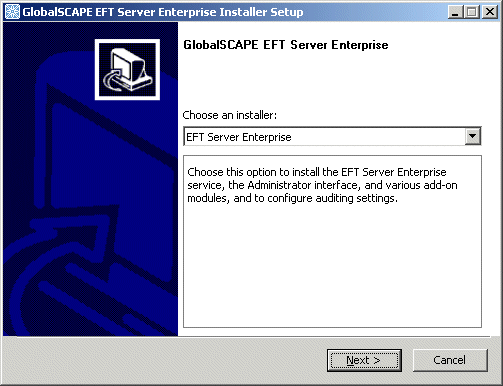
Click the list and then, depending on which edition of EFT Server you downloaded, click GlobalSCAPE EFT Server or GlobalSCAPE EFT Server Enterprise. (Selecting EFT Server or EFT Server Enterprise will also install each of the modules EXCEPT for DMZ Gateway and Secure Ad Hoc Transfer.)
If you are upgrading or reinstalling, the version detected page appears. Refer to Upgrading the Software for the procedure.
Click Next. After installation components are loaded, the Welcome page appears.
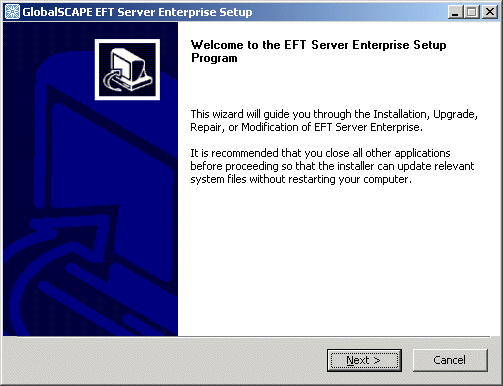
Read the Welcome page, then click Next. The License Agreement page appears.
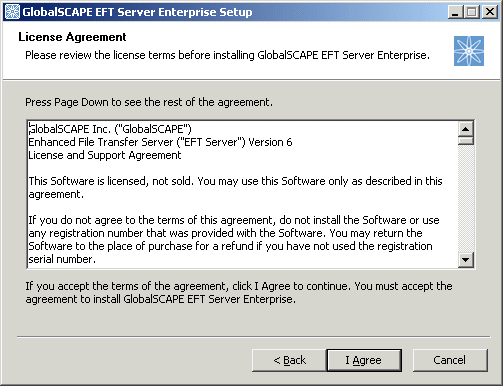
Read the license agreement, then click I agree to accept it. (Clicking Cancel aborts the installation.) The Choose Install Location page appears.
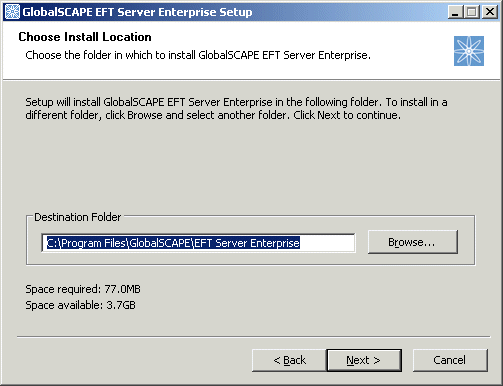
The default installation location appears in the Destination Folder box. Leave the default or click Browse to specify a different folder, then click Next. The Choose Components page appears.
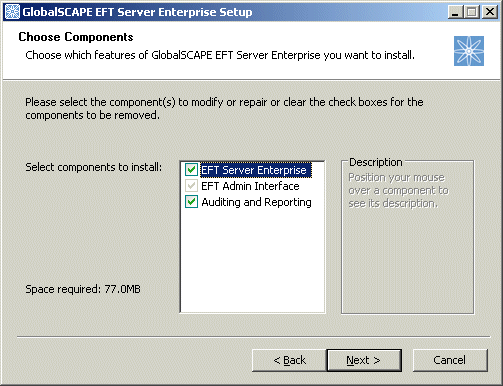
When you install EFT Server, you must also install the EFT Admin Interface. After you have installed EFT Server and Administrator Interface on one computer, you can install the Administrator Interface on other computers for remote administration.
To install only the Administrator Interface, clear the other check boxes. (The EFT Admin Interface check box will still be gray, but it will install.)
If you do not want to install a database, clear the Auditing and Reporting check box.
The Choose Start Menu Folder page appears.
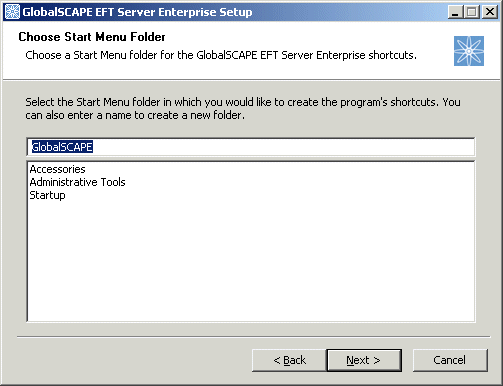
Keep the default shortcuts, specify an existing folder, or type a name for a new folder.
Click Next. The administration account configuration page appears.
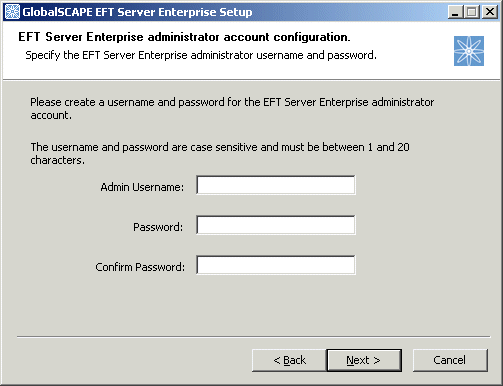
Create a user name and password for the administrator account for connecting to EFT Server from the Administrator. Both the username and password are case sensitive and must be between 1 and 20 characters.
|
|
Remember your user name and password; you need them to connect to EFT Server. |
If you did not select the Auditing and Reporting check box, skip these steps.
If you selected the Auditing and Reporting check box, the database setup page appears.
Specify the type of database to which EFT Server is to connect.
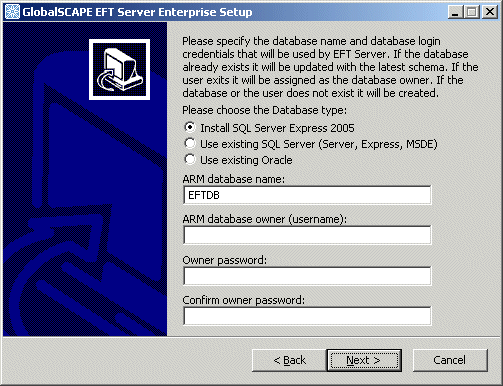
Use existing SQL Server (Server, Express, MSDE)
Use existing Oracle database- (Available in EFT Server Enterprise)
Install SQL Server 2005 Express (recommended for testing purposes only)
Specify the database name (EFTDB by default) and login credentials that EFT Server is to use to connect to the database.
Click Next. The database address and database administrator login credentials page appears.
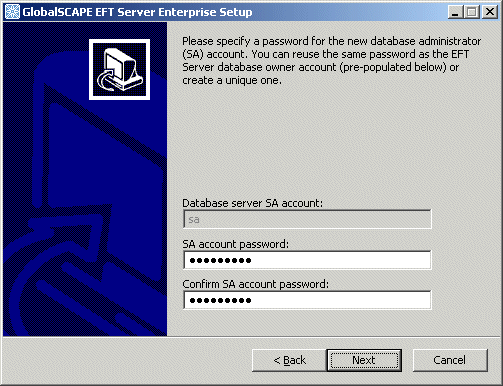
Specify the database host address or instance name and the credentials used by the database administrator to administer the database. (You can use the same password as the EFT Server database owner account, which is populated for you in the wizard.
|
|
The password must meet SQL Server password policy requirements. |
Click Next. If you chose to install SQL Server Express, the SQL Server installer starts.
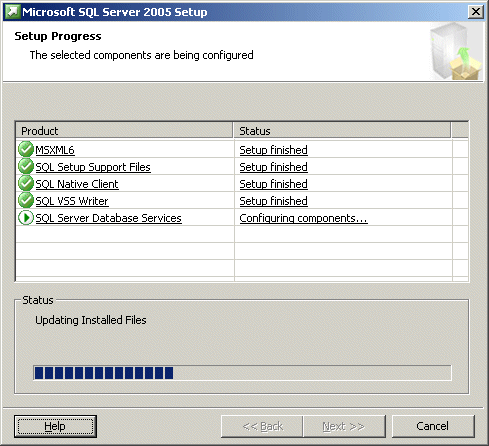
The installer installs the options that you selected, then the Installation Complete page appears.
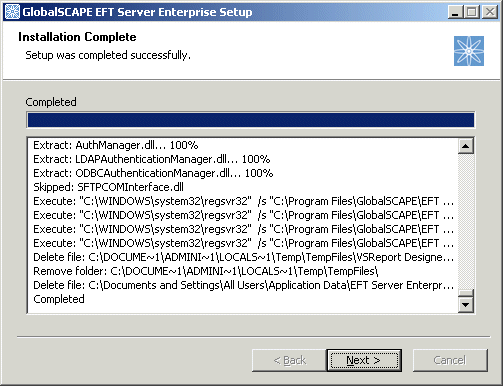
Click Next. A page appears allowing you to start EFT Server, create an Administrator Interface shortcut on the desktop, open the Administrator Interface, and/or view the EFT Server version history.
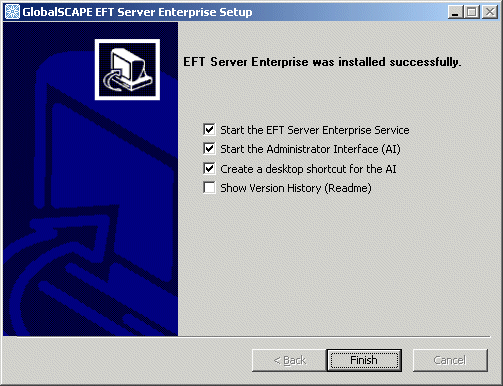
Start the EFT Server Service - Clear the check box if you do not want to start the Service yet. Select the check box if you want to start the service when you click Finish. The service is configured to start automatically when the computer starts. If you do not want the service to start automatically, you will have to configure it to start manually in the Windows Services dialog box.
Start the Administrator Interface - If you do not want to open the Administrator, clear the check box. The Administrator is used to configure EFT Server. You can also open the Administrator by clicking the Start menu.
Create a desktop shortcut - An Administrator Interface shortcut is created on the desktop by default. If you do not want to create a shortcut, clear the check box.
Show version history - If you want to read the release notes, select the Show Version History (Readme) check box. If you want to read it later, the file, notes.txt, is stored in the EFT Server installation directory.
Click Finish. If the Administrator Interface check box was selected and the EFT Server service was started, the Login Wizard appears.
If the service is not started, a prompt appears from which you can start it. Click Cancel if you do not want to start the service.
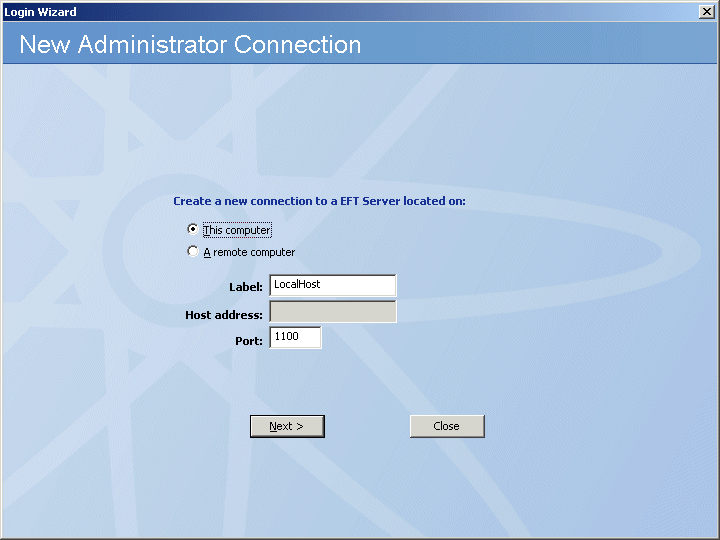
Leave This computer selected, then click Next. The EFT Server Administrator Login page appears.
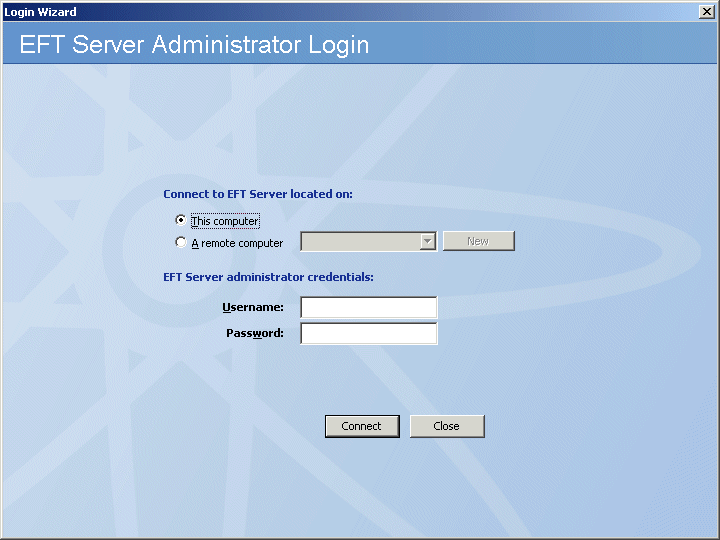
In the Username and Password boxes, provide the login credentials that you created during installation, then click Connect. The Welcome page appears.
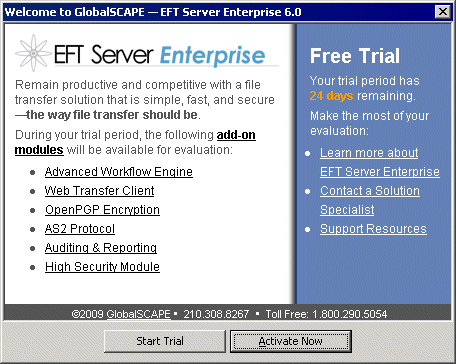
Do one of the following:
If you are evaluating the software, click Start Trial, then follow the procedures to configure EFT Server.
If you have purchased a license, click Activate Now, then follow the procedures for activating the software.
|
|
DMZ Gateway and the Secure Ad Hoc Transfer module are installed separately and also have a 30-day trial period. Refer to their documentation for details. |
|
|
The EFT Server service runs under a user account, which must have full administrative rights to the folder in which you install EFT Server. With administrative rights, the EFT Server service can save all of your settings. If the service does not have administrative rights, you will lose settings and user accounts whenever you restart the EFT Server service, and you will need to reset permissions on the computer on which the EFT Server service is running. |
|
|
If you are using Microsoft IIS, refer to Running EFT Server and Microsoft IIS on the Same Computer. |
System Requirements for EFT Server
Configuration and Security Best Practices
The Server and Microsoft Clustering Services
Setting Windows System Services
Running EFT Server and Microsoft IIS on the Same Computer
Running a Microsoft .NET Web Application in 32-bit Mode in IIS 6.0 on a 64-bit Server
The Server in the Windows Event Viewer